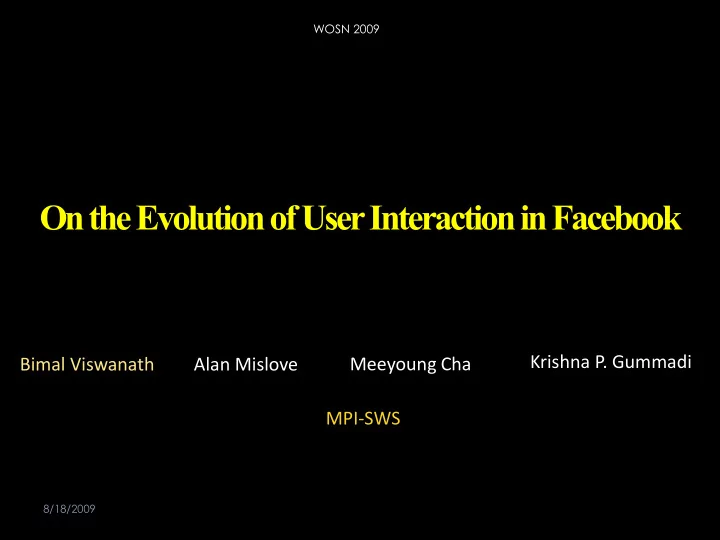

WOSN 2009 On the Evolution of User Interaction in Facebook Krishna P. Gummadi Bimal Viswanath Alan Mislove Meeyoung Cha MPI-SWS 8/18/2009
Social network links Lots of applications use social networks: Countering sybil attacks [ SIGCOMM’06, NSDI’09 ] Web search [ HotNets’06, VLDB’08 ] Recommendation systems [ WWW’08 ] But, social links could represent many things Close real world friends Casual acquaintances Even enemies [ CHI’09 ] In practice, people rarely delete social links Is the current abstraction of links good enough ? 2
Gauging the strength of social links? Idea: Use interaction to differentiate strong and weak links Social network Interaction network This defines an interaction network [ IMC’08 ] 3
Prior studies Previous studies looked at a static snapshot of interaction network [ IMC’08, Eurosys’09 ] Interaction network changes with time Understanding dynamics important for applications 4
This talk We characterize the evolution of user interaction Collected data of user interaction in Facebook Studied how pairwise interactions evolve over time Studied how interaction network as a whole evolve over time 5
Crawling Facebook Facebook reluctant to give out data Performed crawl of user graph Picked known seed user Crawled all of his friends Add new users to list Continued until all reachable users crawled Crawled Facebook New Orleans regional network Over 90,000 users, 3M social links We could create many crawling accounts 6
Collected interaction data Wall post Wall page Able to download entire wall history 800,000 wall posts Link creation time known from wall page 7
Data collection challenges Could not capture all the users’ interaction Only 76% profiles publicly visible Only crawled the giant connected component Represents ~52% of users in New Orleans network Users can interact in other ways also Messages, photo sharing, applications, chat 8
Rest of the talk Local view: Global view: Evolution of Evolution of interaction pairwise interactions network over time 9
Frequency of interaction Only 23.7% of the social links exhibit interaction Focus on the 1st year of interaction for each pair Wall posting distribution among users skewed 80% of pairs exchange no more than 5 posts Light chatter Heavy chatter 10
Light chatter patterns What caused low level of interaction? Did link creation trigger interaction? 39% of posts on birthday wishes 20% interact on first day 80% of pairs post first message evenly over the year 11
Implications of light chatters Likely users who are acquainted with each other, though not close friends Large fraction of such links to be considered while building applications E.g. Maybe not good for recommendation systems OSN site features could cause interaction E.g. Birthday reminders 12
Heavy chatter patterns How does the rate of interaction evolve? Sharp drop in interaction after 1 month General decreasing trend in rate of interaction observed 13
Rest of the talk Local view: Global view: Evolution of Evolution of interaction pairwise interactions network over time 14
Evolution of interaction network Constructed multiple snapshots of interaction network 30, 60, 90, and 180 days intervals We compare network properties of successive snapshots 15
Churn in the interaction network Examine network at 3 months intervals What fraction of links are not present in the next snapshot? 55% [Min = 22% , Max = 61%] What fraction of links were not present in previous snapshot? 27% [Min = 19%, Max = 31%] In contrast, social network links hardly deleted Interaction network changes dramatically! 16
Evolution of structural properties Graph properties remarkably stable 17
Summary Many applications are built using social networks But social links mean many things Idea: Use interaction to differentiate links Previous studies only looked at static snapshots Examined both local and global properties of network Many links backed by very little interaction Interaction network changes dramatically But, graph properties remarkably stable 18
Questions? Data sets available at: http://socialnetworks.mpi-sws.org
Recommend
More recommend